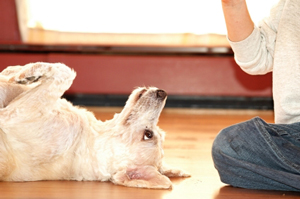Who's in charge?
Have you ever felt that you really have no leadership role in your relationship with your dog because your dog is just performing for food? You are not alone.

Consequences have all the power
There is a common belief that dogs, being pack animals, should behave simply because they are subordinate. The problem with this belief is that behavior doesn't work quite so arbitrarily. Behavior doesn't change simply because someone said it should (it might appear to sometimes, but there is always more to it than that). Operant behavior is increased, maintained, reduced, or stopped by consequences which are either reinforcing or punishing.
These consequences can come from great leaders, poor leaders, machines, or, frequently, even by accident—consider this the next time someone tells you "you need to be alpha!"
Envisioning and reinforcing behavior
Great leaders don't allow behavior to simply occur unguided, appearing random and chaotic. They have a vision of which behaviors they want to see and which ones they don't. They see to it that the behaviors they want to see are reinforced and the behaviors they don't want to see are not reinforced.
Clicker trainers focus on positive reinforcement of desired behaviors. Frequently, this positive reinforcement will come through food. Why not? Food is convenient, cheap, quick, and all dogs need to eat anyway.
What is important is that desired behaviors have been reinforced. If a dog performs for food or performs to avoid a correction, that dog has performed for reinforcement. In the first case, for positive reinforcement and in the second case, for negative reinforcement. In neither case did the dog "behave" just because someone said it should.
The clicker and the ABC model
Why do dogs only seem to perform when their trainers have food? Consider the ABC model of operant conditioning (sometimes called "Three Term Contingency"):
Antecedent -> Behavior -> Consequence
If a trainer always has food, then food becomes an antecedent. The trained behavior is less likely to follow without the antecedent of food. The same could be said if a traditional trainer always had a check chain on the dog; the check chain would become an antecedent.
One of the main benefits of clicker training is that the clicker is used as a "bridge" between behavior and reinforcement. This means you can put the food somewhere else and fade it from the antecedents. In time, and if required, you can then put a finished behavior on a schedule of reinforcement and have the behavior performed without always using a reinforcer.
It should also be noted that food is not the only reinforcer available. For more information on fading reinforcers and a short list of common reinforcers, follow these links:
"86 Reinforcers" by Steve White
"Managing the Treat-Free Competition Ring" by Melissa Alexander



This would be perfect if one
This would be perfect if one thing were corrected. Dogs are not pack animals. http://www.jeandonaldson.com/jeans-blog-mainmenu-51/64-are-dogs-pack-animals
Newbie help.
Hi. I have a problem with my 2-month old rottweiler. Could you help me how to do a proper
"feeding" him for his treats? I'm scared that I may get bitten. The vet said he will get a rabies shot when he is 3 months old and I want to train him as early as now. Thank you. Good day to you.
Newbie help.
I like to use peanut butter to teach a dog to take treats nicely. You can use anything "gooey," though - such as cream cheese, yogurt, or "squeeze cheese." Put a dollop of peanut butter in the palm of your hand. Make a fist so the peanut butter squishes out a little bit. With your clicker ready, offer your peanut butter fist to your dog. When he licks your hand, click and open your hand. Let him have a lick or two then pull your hand away. Present your hand again, clicking when your dog licks and allowing him a lick or two of the peanut butter. When you're confident that your dog will lick your hand (instead of nibbling), you can say "easy" (or another word of your choosing) and then present your hand. Click and treat when the dog licks.
Once you've paired "easy" with the behavior of licking, you can then say "easy" and give your dog a solid treat (a piece of his kibble, for instance). The dog should take the treat gently, as easy should mean lick.
Laurie Luck
For Clickertraining.com
Karen Pryor Academy Certified Training Partner
See my profile and contact information at
<http://karenpryoracademy.com/Luck_Laurie>
http://karenpryoracademy.com/Luck_Laurie
paper training
He was using the potty pads now he just goes ware ever. What has changed and how do I corect it?
Post new comment